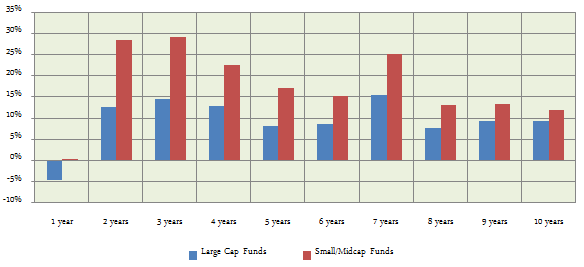What should be the percentage of midcap mutual funds in your portfolio: Part 2

In our previous post on this topic, What should be the percentage of midcaps in your equity portfolio: Part 1, we had discussed that, midcap stocks can give higher returns than large cap stocks, but they are also much more volatile than large cap stocks. The midcap and small cap market segment comprises of a large number of companies, some of which can give superlative returns in the future, but a large number of companies will remain perennial underperformers, and you risk losing your capital when investing in such companies. On the other hand, in our previous post, we had discussed that, good mutual fund managers have the right kind of expertise and experience to select the right small and midcap stocks, which have high potential, both from a value and growth perspectives. Historically, small and midcap funds have outperformed large cap funds over different time periods (for periods ending April 22, 2016).

Source:Morningstar
Over the past year or so, many retail investors have gravitated towards small and midcap equity mutual funds, because these funds have outperformed large cap funds over the past one or two years. In 2015 while large cap funds on average made losses, midcap funds gave positive returns. In fact, some of the good midcap funds gave double digit returns in 2015, while the Nifty was lower by 4%. However, many market experts are saying that, midcap stocks are now more expensive than large cap stocks, and therefore, large cap stocks may outperform midcap stocks in the short term. Our opinion in Advisorkhoj is that, investors should not make equity mutual fund investments based on recent market trends. Equity mutual fund investments should be long term in nature and should be informed by investment goals, time horizon and risk tolerance of the investor.
In this post we will discuss what should be the percentage of small and midcap funds in your investment portfolio. We will share with some common allocations models, popular both in United States and India. We will also share our own analytical perspective on this topic.
Let us first discuss a few equity allocation models that are popular in the US and India. Please note that, we are talking of equity allocation portion only of the asset allocation models.
Charles Schwab:
Charles Schwab has 5 different risk profile models. In the conservative and moderately conservative models, they have around 75% allocated to large cap and 25% to others. In the moderate and the moderately aggressive models, they have around 60% allocated to large cap, 20% to small and midcap, and the balance to others. In the aggressive model, they have around 50% allocated to large cap, 20% to small and midcap, and the balance to others.Wells Fargo:
Wells Fargo has 3 different risk profile models. In the conservative model, they have around 60% allocated to large cap and 40% to small / midcap. In the moderate model, they have around 55% allocated to large cap and 45% to small / midcap. In the high growth model, they have around 50% allocated to large cap and 50% to small / midcap.CNN Money:
CNN Money has different risk profiles. For conservative and moderate risk profiles, they have 55% allocated to large cap, 20% allocated to small/midcap and balance to others. For aggressive risk profiles, they have 50% allocated to large cap, 25% allocated to small/midcap and balance to others.- In India we have seen that, in the online asset allocation calculators usually 60 – 70% is allocated to large cap and 30 – 40% to midcap. If you compare this with some popular US based asset models, discussed above, you can see that the large cap to midcap ratio is similar to the US based asset allocation models.
You can choose any of the above models because they all are relatively similar. How will you know, whether your risk profile is conservative, moderate or aggressive? The online asset allocation calculators use your age to assess your risk profile and sometimes have a risk questionnaire, based on which they profile your risk appetite. Will these market cap allocations give you the best result? These models have been derived on some heuristics, which on an average have given good results to investors. But we, in Advisorkhoj, have a different take on this. Studies in the US have shown that investors have underinvested in small / midcap stocks and funds, and a result have lost out on a big chunk of returns that midcap stocks and funds delivered over the past many years. We believe that, your ideal equity allocation mix should be determined BY you in consultation with your financial advisor. However, when you are discussing you equity allocation market cap mix with your financial advisor three outcomes are possible.
- The advisor may give recommendations based on the models discussed above, or some other asset allocation model, without factoring in all the different nuances of your investment objectives, your financial situation and your investment temperament.
- The advisor may give recommendations based on his or her personal views on different market cap segments / equity fund categories. As discussed in our previous post, some advisors are biased towards small/midcap funds, while some others may make recommendations based on current market views on valuations.
- The advisor will give recommendations based on your investment goals, investment horizon, your risk capacity, your investment temperament, including but not limited to your tolerance for volatility and your investment experience.
The third outcome is definitely the most desirable one, because it will give you the best results. But to make the third outcome a reality, you need to be very clear about your investment goals, horizon and risk tolerance. You need to understand the benefits of diversification, not just across sectors, but also across market cap segments. Most importantly, you need to understand the relationship between risk and returns, and more importantly, what the implications are for your portfolio returns, under different risk scenarios. Your financial advisor may be familiar or not familiar with these concepts. Even if the advisor is familiar with these concepts, and some are, he or she may not be able to explain it to you, unless you also have an understanding of these concepts. Therefore, it is important that, you educate yourself about these concepts so that you can work more productively with your financial advisors.
It is important to understand the benefits of diversification from a risk perspective. Diversification is not just related to sectors, it also applies to market segments. Diversification can improve your risk adjusted returns. While most investors may be familiar with the concept of risk return relationship, an analytical understanding of risk, especially its impact of portfolio returns, is a much more complex concept. Many investors are worried about volatility. However, investors should ask themselves that, over a long investment horizon, are they worried about volatility of the risk of loss of capital? Loss of capital and volatility are two different things, which we have discussed a few times in our blog. In the next part of this post, we will discuss the risk return characteristics of various mixes of large cap and midcap mutual funds in our portfolios.
Conclusion
In Advisorkhoj, we will try to follow a data driven analytical approach to investment portfolio management. An analytical data driven approach precludes personal biases and gut-feel. One of my seniors, for who I have a lot of respect, told me almost a decade back that, business and investment decisions should be based on gut-feel and not data. I begged to differ with him back then and my belief has been further reinforced over time. Today more and more businesses are turning to analytics for decision making, and they are getting terrific results. You no longer have to rely on wisdom from the past. The common wisdom of the past was that, equity as an asset class, gives you 15%+ annualized returns in the long term. On January 14, 2008 the Sensex was at 20,728 and on April 29, 2016 the Sensex is at 25,606. What is the compounded annual return over this period of nearly 8.5 years? It is only around 2.6%, much less than the risk-free return. Are we saying, equity is no longer the best asset class? Are we saying that, people did not make any money in equities in the last 8 to 9 years? The answer to both the questions above is no, we are not.
We still believe that, equity is the best asset class in the long term. Some people actually made a lot of money in the last 8 to 9 years, much higher than fixed income returns over the same period. All we are saying is that, conventional wisdom of the past may not work so well in the future. Therefore, instead of relying on conventional wisdom, if you base your investment decisions on risk return analytics synced with your own investment objectives, you may stand to gain much more. The last 20 years was the age of information. Information is now a commodity; almost everybody has it. The next 20 years or maybe even more, will be the age of knowledge. Knowledge will obviously be based on information, but a distinction has to be made between information and knowledge. In our next post, we will discuss the risk return characteristics of various portfolio mixes of large cap and small/midcap equity funds. We will discuss in the next post, how different portfolio mixes of large cap and small/midcap funds give different results, particularly with relation to the actual risk taken by the investor. The results may surprise you. Stay tuned to our blog for more........
RECOMMENDED READS
Sundaram Asset Management Company is the investment manager to Sundaram Mutual Fund. Founded 1996, Sundaram Mutual is a fully owned subsidiary of one of India's oldest NBFCs - Sundaram Finance Limited.
Quick Links
- Interview - Mr. Dwijendra Srivastava - CIO - Fixed Income
- Interview - Mr. Sunil Subramaniam - CEO
- Sundaram Select Midcap Fund: Consistent outperformance makes it a big wealth creator
- Interview - Mr. Sunil Subramaniam - CEO
- Fund Manager Interview - Mr. Krishna Kumar - CIO - Equities
- Sundaram Rural India Fund: This thematic Mutual Fund aiming good long term returns
- Sundaram Equity Multiplier: Long term wealth creation potential
- Our Articles
- Our Website
- SIP one sheeter-Investor Education initiative
- Sundaram Asset Management Singapore
- Returns Calculator
- SEBI Investor Awareness Initiative
- Check your KYC Status
- KYC Forms & FAQs
- Recieve your PIN
- A note on NIGO
- FAQs on RGESS
- FAQs on Direct Plan
- Receive Updates
- Share your views
- Transmission Checklist
- Equity Application Form
- Fixed Income Application Form
- Transaction Slip
- Factsheet May - 2016
- MF Tax Reckoner 2015
Follow Sundaram MF
More About Sundaram MF
POST A QUERY




